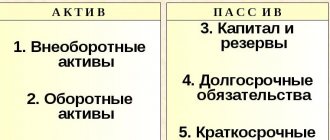Line 1170 “Financial investments”
Line 1170 reflects information about the organization’s financial investments, the circulation (maturity) period of which exceeds 12 months after the reporting date:
plus
(in terms of amounts on deposit accounts related to long-term investments)
minus
(in terms of amounts related to long-term investments)
plus
(in terms of long-term interest-bearing loans issued to employees)
Financial investments include:
- state and municipal securities;
- securities of other organizations, including debt securities in which the date and cost of repayment are determined (bonds, bills);
- contributions to the authorized (share) capital of other organizations (including subsidiaries and dependent business companies);
- loans provided to other organizations;
- deposits in credit institutions;
- receivables acquired on the basis of assignment of the right of claim;
- other similar investments.
Financial investments include:
- own shares purchased by the joint-stock company from shareholders for subsequent resale or cancellation;
- bills issued by the organization-promissory note to the organization-seller when paying for goods sold, products, work performed, services rendered;
- investments of an organization in real estate and other property that has a tangible form, provided by the organization for a fee for temporary use (temporary possession and use) for the purpose of generating income;
- precious metals, jewelry, works of art and other similar valuables acquired for purposes other than normal activities.
The actual costs of acquiring assets as financial investments are:
- amounts paid in accordance with the contract to the seller;
- amounts paid to organizations and other persons for information and consulting services related to the acquisition of these assets. If an organization is provided with information and consulting services related to making a decision on the acquisition of financial investments, and the organization does not make a decision on such acquisition, the cost of these services is included in the financial results of a commercial organization (as part of other expenses) or an increase in the expenses of a non-profit organization of that reporting period when the decision was made not to purchase financial investments;
- remuneration paid to an intermediary organization or other person through which assets were acquired as financial investments;
- other costs directly related to the acquisition of assets as financial investments.
The initial cost of financial investments received by an organization free of charge, such as securities, is recognized as:
- their current market value as of the date of acceptance for accounting. For the purposes of these Regulations, the current market value of securities is understood as their market price, calculated in the prescribed manner by the organizer of trading on the securities market;
- the amount of funds that can be received as a result of the sale of received securities on the date of their acceptance for accounting - for securities for which the market price is not calculated by the organizer of trading on the securities market.
When disposing of an asset accepted for accounting as a financial investment for which the current market value is not determined, its value is determined based on an assessment determined in one of the following ways:
- at the initial cost of each accounting unit of financial investments; at the average initial cost;
- at the original cost of the first financial investments acquired (FIFO method).
In the financial statements, at least the following information is subject to disclosure, taking into account the materiality requirement:
- methods for assessing financial investments upon their disposal by groups (types);
- the consequences of changes in the methods of assessing financial investments upon their disposal;
- the value of financial investments for which the current market value can be determined, and financial investments for which the current market value cannot be determined;
- the difference between the current market value as of the reporting date and the previous assessment of financial investments by which the current market value was determined;
- for debt securities for which the current market value has not been determined - the difference between the initial value and the nominal value during their circulation period;
- value and types of securities and other financial investments encumbered with collateral;
- the value and types of retired securities and other financial investments transferred to other organizations or persons (except for sale);
- data on the reserve for impairment of financial investments, indicating: the type of financial investments, the amount of the reserve created in the reporting year, the amount of the reserve recognized as other income of the reporting period; reserve amounts used in the reporting year;
- for debt securities and loans provided - data on their valuation at discounted value, on the value of their discounted value, on the discounting methods used (disclosed in the notes to the balance sheet and profit and loss statement).
Related links:
PBU 19/02 “Accounting for financial investments”
Financial investments on the balance sheet: definition, list
Contrary to the opinion of some accountants, the following assets cannot be accepted by an organization for accounting as financial investments:
Take our proprietary course on choosing stocks on the stock market → training course
- Own shares of the enterprise that were purchased from shareholders with the purpose of their cancellation or resale;
- material assets purchased for purposes other than normal activities, such as works of art, jewelry, precious metals, etc.;
- bills issued as payment for sold goods, products, works or services issued by the drawer to the seller;
- investments in real estate that have a tangible form and are transferred by the company on a reimbursable basis to other persons for temporary possession (use);
- fixed assets, intangible assets and various types of inventories.
The assets listed below, on the contrary, are full-fledged financial investments, the value of which can be recorded on line 1170 (subject to the requirements from the list following the list):
- municipal and state securities;
- securities of other companies, including debt - bills of exchange, bonds (provided that they indicate the cost and maturity date);
- receivables repurchased in connection with the assignment of claims;
- contributions to the authorized (share) capital of other companies (including subsidiaries and affiliates);
- bank deposits;
- loans issued to other companies;
- other similar investments.
Assets and investments can be accepted for accounting as financial investments only if all the following conditions are met:
- The enterprise must retain documents proving the fact of making a financial investment in the object.
- The investing company must have certain financial risks related to the acquired income-generating assets.
- There must be a probability that financial investments will bring economic benefits in the future in its various forms (in the form of dividends, an increase in the initial cost, etc.).
Conclusions about what a change in indicator means
If the indicator is higher than normal
Not standardized
If the indicator is below normal
Not standardized
If the indicator increases
Usually a positive factor
If the indicator decreases
Usually a negative factor
Notes
The indicator in the article is considered from the point of view not of accounting, but of financial management. Therefore, sometimes it can be defined differently. It depends on the author's approach.
In most cases, universities accept any definition option, since deviations according to different approaches and formulas are usually within a maximum of a few percent.
The indicator is considered in the main free online financial analysis service and some other services
If you need conclusions after calculating the indicators, please look at this article: conclusions from financial analysis
If you see any inaccuracy or typo, please also indicate this in the comment. I try to write as simply as possible, but if something is still not clear, questions and clarifications can be written in the comments to any article on the site.
Best regards, Alexander Krylov,
The financial analysis:
- Profitable investments in material assets 1160 Definition Profitable investments in material assets 1160 - investments of an organization in property, buildings, premises, equipment and other material assets provided by the organization for a fee for a temporary...
- Fixed assets 1150 Definition Fixed assets 1150 are: buildings, structures, working and power machines and equipment, measuring and control instruments and devices, computer technology, vehicles, tools, ...
- Intangible assets 1110 Definition Intangible assets 1110 are: works of science, literature and art; programs for electronic computers; inventions; utility models; breeding achievements; production secrets (know-how); commodity...
- Other non-current assets 1190 Definition Other non-current assets 1190 are assets whose circulation period exceeds 12 months and which are not reflected in other lines of Section I of the balance sheet. To them…
- Deferred tax assets 1180 Definition Deferred tax assets 1180 are an asset that will reduce income taxes in future periods, thereby increasing after-tax profits. The presence of such an asset...
- Tangible exploration assets 1140 Definition Tangible exploration assets 1140 - costs of searching, evaluating mineral deposits and exploring mineral resources in a certain subsoil area. As a result of their implementation...
- Intangible exploration assets 1130 Definition Intangible exploration assets 1130 - costs of searching, assessing mineral deposits and exploring mineral resources in a certain subsoil area: the right to perform work...
- Research and development results 1120 Definition Research and development results 1120 are funds spent on research and development work that yielded a positive result. The works for which the results were obtained are taken into account:...
- Asset structure (share in the total balance sheet), in percent Asset structure. The assets of the enterprise are divided into 2 large groups: non-current assets (immobilized funds), the service life of which is more than 12 months; current assets (mobile assets), service life...
- Liquidity and solvency of the bank Hello. This article covers several key indicators of bank liquidity. They characterize the bank’s liquidity along with the mandatory standards of Instruction 139-I of the Bank of Russia. These indicators are used in…
List of actual expenses for the acquisition of assets as financial investments
The accounting records of an enterprise must necessarily contain information about the expenses actually incurred by the company in connection with the need to acquire assets in the form of financial investments. Only the following costs may be included in such costs:
- The amount paid to the seller in accordance with the purchase and sale agreement at the time of purchase of an asset that is planned to be accounted for as a financial investment.
- Expenses for the services of intermediaries involved in the transaction of purchase and sale of an asset acquired as a financial investment.
- Costs for paid services of lawyers and experts who are ready to advise the company on financial investments on a paid basis. If, after the organization paid for information (consulting) services, management decided that it was inappropriate to make a financial investment:
- non-profit organizations include such costs in the increase in expenses of the reporting period, during which it was decided not to invest in the purchase of an asset as a financial investment;
- commercial firms include costs for “unused” consultations and information resources as other expenses.
- Other costs that are directly related to the purchase of assets taken into account as financial investments.
Important! At least once a year, an enterprise is required to check its financial investments for impairment (as of December 31 of the reporting period) if signs of impairment are detected. In addition, studies can be scheduled for interim reporting dates. If, based on the results of the audit, a significant decrease in the value of financial investments is established, it is necessary to create an impairment reserve. The amount of the reserve is determined by deducting their estimated value from the initial cost of financial investments.
Fixed assets
Handbook for an accountant of a trading enterprise (+ CD-ROM) / M.N. Agafonova. - M.: Reed Group, 2015. - 960 p.
- Anishchenko, A.V. LLC. From creation to liquidation. We act according to new rules / A.V. Anishchenko. - M.: Eksmo, 2015. - 192 p.
- Babchenko, T.N. Accounting and taxation / T.N. Babchenko, E.N. Galanina. - M.: KnoRus, 2014. — 456 p.
- All accounting provisions. - M.: Eksmo, 2014. - 224 p.
- Gartvich, A.V. Accounting for 10 days / A.V. Gartwich. - M.: Phoenix, 2015. - 176 p.
- Gartvich, Andrey Accounting from scratch. Self-instruction manual / Andrey Gartvich. - M.: Peter, 2014. - 400 p.
- Kasyanova, G. Yu. Accounting-2012. Accounting and tax / G.Yu. Kasyanova. - M.: ABAC, 2015. - 856 p.
- Kolodin, A.G. Accountant's Handbook. Theory and practice of accounting support for enterprises of any form of ownership and type of activity / A.G. Kolodin. - M.: AST, Astrel, Harvest, 2015. - 718 p.
,
Internet resources:
- http:/www1.minfin.ru/ru/sitemap/ - website of the Ministry of Finance of the Russian Federation.
- http:/www.pfrf.ru/sitemap/ - website of the Pension Fund of the Russian Federation.
- http:/fss.ru/ website of the Social Insurance Fund.
- https://www.ifns.su/ - website of the Federal Tax Service.
- https://www.nalog.ru/ - official website of the Federal Tax Service
- https://ibuh.ru/taxes/3851/61128
- https://ibuh.ru/themes
- www.consultant.ru – SPS “Consultant Plus”
- https://www.referent.ru/ — SPS “Referent”
- www.garant.ru/ - Garant (legal reference system)
1 2 3 4 5
>Related:
Literature lit.na5bal.ru
Calculation of the indicator on line 1170 “Financial investments”: formula based on the balance sheet
As can be seen from the name of the line of the Balance Sheet, on line 1170 “Financial investments” it is customary to reflect information about the financial investments of the enterprise, the circulation (maturity) period of which is more than 1 year after the reporting date . The indicator value is calculated using the following formula based on the company’s balance sheet data:
The “Explanations” column provides an indication of the disclosure of the indicator. In cases where a company decides to draw up Explanations for Form No. 1 and OFR using the forms from the Examples of Explaining Explanations (Appendix 3 to Order of the Ministry of Finance No. 66n), Tables 3.1 and 3.2 should be indicated in the “Explanations” from line 1150 “Financial investments” .
The cost of long-term financial investments is reflected in the balance sheet as of 2 dates: December 31 of the previous year and the same day of the year preceding the previous one.
An example of determining the cost of financial investments (calculation, postings)
JSC “Your Housing” decides to buy out 1,200 shares of JSC “Stroy Vostok” in January of the current period. Each security cost the joint-stock company 2,300 rubles. In addition, the company had to incur costs for specialist consultation in the amount of 21,000 rubles (including VAT of 4,215.33 rubles). The accountant will record the transactions in the following order:
| Operations | Amount (rubles) | DEBIT | CREDIT |
| Securities accepted for accounting | 2 760 000 | 58.01 | 76 |
| Additional costs involved in the formation of the initial cost of shares are taken into account | 21 000 | 58.01 | 76 |
| The money was transferred to the counterparty, the accounts payable under the transaction were repaid | 2 760 000 | 76 | 51 |
So, since the amounts of additional costs are also taken into account when forming the value on line 1170, the accountant will reflect on the specified line of the balance sheet an indicator equal to 2,760,000 rubles.
Example of filling out line 1170 “Financial investments”
Let's imagine a hypothetical enterprise, Kras Finance LLC. Let's turn to the company's balance sheet - there are no account indicators in the accounting. 55 s/sch. 55.3. Let's consider the available indicators for accounts 58, 59, 73 s/sch. 73.1:
The information will be reflected in the Balance Sheet as follows (fragment of form No. 1):
Let's calculate the cost of the company's long-term financial investments minus the formed reserve:
Now we can imagine how the received information will be reflected in Form No. 1 of the Kras Finance LLC enterprise:
What information is subject to disclosure in financial statements regarding financial investments?
The accountant of an enterprise making financial investments must disclose in the financial statements at least the information listed below (provided that they are material):
- methods chosen by the organization for assessing financial investments in the event of their disposal (by groups, types) and the expected consequences of changing the methods of such assessment;
- information on issued borrowed funds and available debt securities (namely data on their valuation at discounted value, on the amount of such value, on the selected discounting methods) - such information is subject to disclosure in the notes to the Profit and Loss Statement and the balance sheet;
- the cost of financial investments for which it is realistic to find out the current market value;
- the value of financial investments for which it is impossible to determine the amount of the current market value;
- the difference between the previous assessment of financial investments, which the company relied on to calculate the current market value, and the current market value as of the reporting date;
- information about the reserve formed in case of depreciation of financial investments (here you will need to explain the type of investment, the amount of the formed reserve for the reporting year, the amount of the reserve used during the reporting year, the amount of the reserve included in other income in the reporting year);
- types and value of financial investments, taking into account securities that were transferred to other legal entities (not sold);
- the cost and types of securities and other investments that are encumbered with collateral;
- the difference between the size of the initial cost and the nominal value during the circulation period of the securities (for debt securities for which the current market value could not be determined).
Trading securities. Methodology for reflecting securities according to IFRS
Methodology for reflecting securities according to IFRS
The methodology for recording securities under IFRS should be based on the new editions of IAS 32 “Financial Instruments: Disclosure and Presentation” and IAS 39 “Financial Instruments: Recognition and Measurement”, which came into force on January 1, 2005. The new edition of IAS 32 replaces the interpretations of SIC 5 “Classification of financial instruments - contingent redemption provisions”, SIC 6 “Share capital - newly acquired own equity instruments”, SIC 17 “Capital - costs of transactions affecting the capital of the company”. These interpretations no longer apply.
Investments in securities represent investments in securities of those companies over which the bank does not have any control and cannot exercise significant influence on their activities. Depending on the purpose of acquisition and terms of sale, securities are classified in the following order: - trading securities; — investment securities held to maturity; — investment securities available for sale. Securities lent to counterparties continue to be recognized as securities in the financial statements. The Notes must additionally disclose information that the securities on the bank's balance sheet are pledged on the basis of a concluded agreement to repurchase these securities. Securities received as a loan are not reflected in the bank's financial statements. In it, the funds paid must be reflected as a loan to clients/banks and are taken into account in the same way as the requirements for accounting for loans. If these securities are sold to third parties, the financial result from the acquisition and sale of these securities is reflected in the Profit and Loss Statement in the line “Income less expenses from transactions with trading securities.” The obligation to return these securities is recorded at fair value as a trading liability.
Trading securities
Trading securities also include securities received during the execution of the following transactions, if the bank has the intention to sell them within three months in order to make a profit: - securities sold as part of a transaction under repurchase agreements; — securities transferred on loan; — acquisition (accounting) of bills. Trading securities are securities that are purchased for the purpose of generating a profit from short-term price fluctuations and/or trading margins, or securities that are part of a portfolio that is actually used by the Bank to generate short-term profits. The Bank classifies securities quoted and unquoted under the legislation of the Russian Federation into the category “Trading securities” under IFRS if there are intentions to sell them within 6 months (180 calendar days) from the date of acquisition. The responsible employee of the bank forms and documents a reasoned judgment on trading securities in the form approved in the bank’s regulations on the transformation of financial statements. The data presented in the reasoned judgment is transferred to the adjustment sheet. If the securities portfolio is large enough, a development table for trading securities is created to form a professional judgment. The following is documented professional judgment. As an example, a judgment on the reversal of securities reserves is given.
I approve the Deputy Chairman of the Board _____ “___” December 2005
The Bank classifies debt and equity securities quoted under the laws of the Russian Federation into the “Trading Securities” category under IFRS, with the exception of debt securities for which there are intentions to be held to maturity. Such securities are classified as either “available-for-sale investment securities” or “held-to-maturity investment securities.” A motivated judgment on this issue is formed by a responsible employee of the Bank. The data presented in the reasoned judgment is transferred to the adjustment sheet and included in the transformation table. The Bank classifies discounted bills of exchange into the category “Trading securities” according to IFRS if the following conditions are met: - the bill of exchange was acquired for the purpose of resale within 6 months (180 calendar days) from the date of acquisition; — information about the financial condition of the drawer (payer of the bill) is published in the media and (or) disclosed on websites; - the bill is not overdue in accordance with bill of exchange legislation. A motivated judgment on this issue is formed by a responsible employee who is entrusted with the authority to form judgments on bills. This information is included in the transformation table. Trading securities are carried at fair value.
How to reflect financial investments in accounting
Important! Before information about current financial investments is reflected on line 1170 of the Balance Sheet, their value is collected in account 58 “Financial Investments”. At the same time, deposits must be accounted for in subaccount 55.3 “Deposit accounts” of account 55 “Special accounts in banks”. Interest-bearing loans issued to employees of an organization can be reflected in account 73 “Settlements with personnel for other operations” (subaccount 73.1 “Settlements on loans provided”).
If a company has made financial investments in securities, the following information about them must be reflected in analytical accounting:
- full name of the issuer of securities;
- price of securities;
- details, name of the paper;
- the total number of securities purchased;
- storage location for purchased papers;
- the date of purchase of the asset and the day of their disposal.
No matter what accounts information about investments is generated, financial indicators will always be reflected on line 1170 of the balance sheet.
Accounting for interest on financial investments
Operations for the provision of loans are reflected using subaccount 58.3 “Loans provided”. Such financial investments must be formalized by loan agreements. Essential information in the agreement is the amount and term of the loan, as well as the amount of interest accrued on such obligations.
Typical wiring may look like this:
| Dt | CT | Operation description |
| 58.3 | 51 | The amount provided to the borrower is reflected |
| 76 | 91 | Interest accrued on the loan provided |
| 51 | 76 | The borrower paid interest on the loan |
| 51 | 58.3 | Loan repayment |






